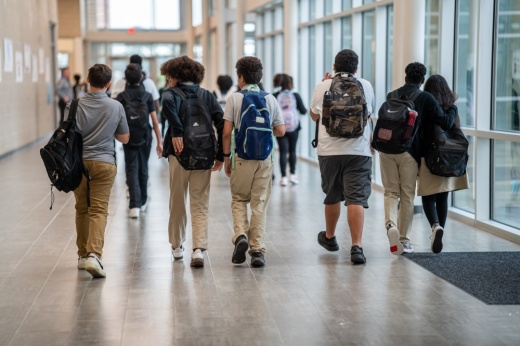The resulting exodus of students from public school districts is causing funding challenges for local schools. For fiscal year 2024-25, Spring ISD is facing a $25 million funding shortfall, which districts officials said can be attributed, in part, to students choosing alternative schooling options.
School districts receive state funding based on attendance, making student enrollment an important factor as they face state financial hurdles. In the last decade, SISD’s enrollment has decreased overall while Klein ISD’s wavered from 2018-20 and is growing again, but at a slower rate than 2012-17.
The overview
Community Impact analyzed data from the Texas Education Agency on transfers from local school districts and total enrollment. Transfer data from the TEA for the 2022-23 school year shows 14% of students zoned to Spring ISD and 4% of students zoned to Klein ISD left the district for charter or public schools in a different district.Of 27 Greater Houston-area school districts analyzed by Community Impact, TEA data revealed SISD had the fourth-highest percentage of net transfers compared to total enrollment for the 2022-23 school year, behind Houston, Alief and La Porte ISDs.
TEA data also shows the students who are leaving are largely choosing charter schools, which continue to open in the Spring and Klein areas. Enrollment opened in February for Yes Prep North Rankin Elementary School’s inaugural 2024-25 school year, and officials with Harmony Public Schools broke ground in March on a new elementary campus in City Place. Slated to open for the 2025-26 school year, Harmony Science Academy-City Place will be followed by a combined middle and high school campus set to open in 2027.
Educational options are not limited to charter schools, however. No Texas agency tracks private or homeschool students, but TEA and U.S. Census Bureau Annual Community Survey data shows about 21% of kids ages 5-19 living in KISD’s boundaries and 24% living in SISD’s boundaries are choosing one of these options.
ACS five-year estimates data shows 68,084 kids ages 5-19 lived within KISD’s boundaries and 45,104 lived within SISD’s boundaries in 2022. KISD’s enrollment for the 2022-23 school year was 53,712, and SISD’s was 34,114, meaning the districts captured about 79% and 76%, respectively, of possible students.
By the numbers
Despite growth in the area population, SISD enrollment has dropped by about 6% in the last decade, while the number of students transferring out each year for charter schools or other public school districts increased about 148% in the same time frame. Simultaneously, KISD saw 14% enrollment growth and 85% more students leaving for charters and other public schools.Public school—which includes charter schools—enrollment has increased at a slower rate statewide compared to before the coronavirus pandemic, said Bob Popinski, senior director of policy at Raise Your Hand Texas, a nonprofit education advocacy group.
“[Texas schools] do base our funding off of average daily attendance, so when enrollment declines and attendance declines, you get into some issues with funding,” Popinski said.
The cost
SISD is facing a $25 million budget shortfall for fiscal year 2024-25. The anticipated funding gap is “largely due” to a lack of state funding, but can also be attributed to decreased student enrollment, SISD officials said in a March 22 email.
“This trend is ... seen across many districts,” the email reads. “While it’s challenging to quantify the exact impact, it’s clear that decreased enrollment directly affects our funding, as it is partly based on student attendance.”
KISD leaders are budgeting with enrollment trends in mind, KISD Chief of Staff Dayna Hernandez said in a March 21 email.
“While student transfers can affect our enrollment, KISD is an established district that continues to attract families,” Hernandez said.
Charter schools also receive state funding and were impacted by a lack of funding dedicated to schools during the 88th state legislative session, Popinski said.
Who it's for
In north Houston, around a dozen charter schools have opened in the last decade, including Harmony and Idea public schools, School of Science and Technology campuses, and Sam Houston State University charter schools, among others.“Not everyone is meant to go to a big ISD—it’s easy to get lost there,” said Sally Magnuson, director of communications and marketing for Harmony Public Schools Houston North District. “For probably 90% of kids, it works out great. But for the others who can’t afford private school, it’s a really good choice.”
Since its inception in 2006, Harmony Public Schools Houston North District has grown to include 11 campuses. Statewide, the charter school system comprises 65 campuses and plans to reach 70 campuses by 2025, Magnuson said.
Mary Dramis, who lives within KISD’s boundaries, opted to enroll her seventh grade son at the virtual school program Texas Connections Academy through Houston ISD, where she says her son is thriving.
“His grades are up, and he’s able to focus on the curriculum,” Dramis said. “We’re even going on more field trips as a family.”
Meanwhile, Spring and Klein ISDs both offer specialized programming at select campuses. SISD offers atypical learning programs, including Momentum High School, a school of choice with blended in-person and virtual classes; Spring Early College Academy, where students can earn a high school diploma and associate degree simultaneously; and partnership pathways with Lone Star College.
Similarly in KISD, Klein Oak High School boasts an International Baccalaureate program, and KISD’s Early College High School partners with LSC-University Park to give students an opportunity to earn up to 60 hours of tuition-free college credit while earning their high school diploma.
Contributions by Hannah Brol, Wesley Gardner & Brooke Sjoberg.





